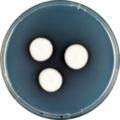| Aspergillus bicolor | |
|---|---|
| Scientific classification | |
| Kingdom: | Fungi |
| Division: | Ascomycota |
| Class: | Eurotiomycetes |
| Order: | Eurotiales |
| Family: | Aspergillaceae |
| Genus: | Aspergillus |
| Species: | A. bicolor |
| Binomial name | |
| Aspergillus bicolor M. Christensen & States (1978) [1] | |
Aspergillus bicolor is a species of fungus in the genus Aspergillus . It is from the Aenei section. [2] The species was first described in 1978. [1] It has been reported to produce sterigmatocystin, versicolorins, and some anthraquinones. [2]

